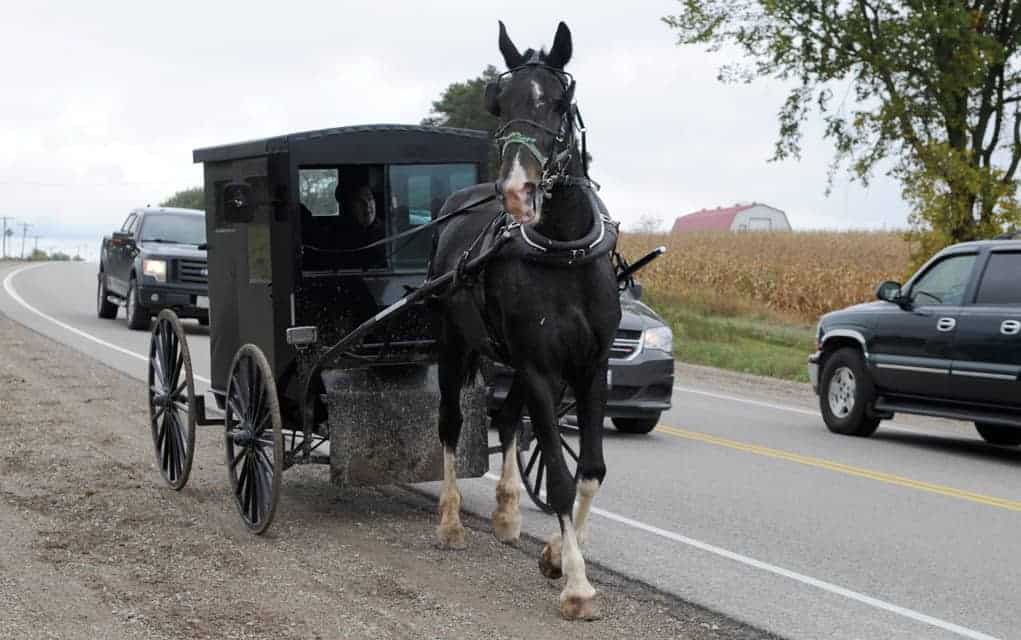Car fanatics are quick to spew stats on how much horsepower their prized Camaro or Corvette has, but do they know what horsepower even means?
For most of us, it has nothing to do with horses. For Mennonites, who live largely off the grid, what kind of literal horsepower do they have when they travel – as they do – by horse-drawn buggy?
Local Old Order Mennonites Wesley and Esther Weber explain how horsepower factors into their life.
“I once had a horse that did about 30 miles an hour, but that’s a short distance. If a horse travels 10 miles an hour at an average speed he’s an extremely good horse. That’s with a buggy and a couple of people on it,” Wesley says.
They’ll use one horse if it’s pulling a buggy and a couple people, but if it’s the whole family they’ll add a second horse – their way of increasing horsepower. Doubling it, in fact.
Technically, horsepower refers to a unit of power equal to 550 foot-pounds per second, or 745.7 watts. The term was coined by James Watt in the late 18th century to compare steam engines and draft horses.
Nowadays, a car’s horsepower ranges anywhere from 109 for a 2014 Nissan Versa Note, for instance, to 788 for a 2015 Ferrari LaFerrari.
![Unlike cars, horses powering the buggies come with a mind of their own, a good reason for drivers to give them a wide berth when passing.[Whitney Neilson / The Observer]](https://www.observerxtra.com/content/images/wp-content/uploads/2015/10/post_horse.jpg)
When drivers estimate how long it will take to get to their destination, they’re basing it off of the highway’s speed limit, so anywhere from 80-100 km/h in Ontario. For horse-and-buggy drivers, Wesley says they budget travel time off of 10 miles an hour – a notably slower pace.
But there’s more than speed to consider when looking at these two modes of transportation.
“It’s a slower pace of life so you see more in a short distance. Basically the reason that we don’t drive cars is not that we’re saying there’s anything wrong with it. It’s just we choose not to because of the effects it can have on the next generation,” Wesley said.
And there’s good reason for concern. With a constantly expanding global population requiring transportation, there’s more stress on the Earth and its resources.
Margaret Insley, associate professor and economics department chair at University of Waterloo, explains what to take into account when comparing the two.
“Cows produce a lot of greenhouse gases but horses don’t. If you look at the feed and so on, if you do all that, it seems that in terms of the impact on the environment the horse is better, a horse and buggy is better. So if you’re looking at an individual decision, if someone decides to travel by horse and buggy I think that would be a benefit to the environment. If they make that choice because personally they like that, then that’s good. It’s sort of like choosing to ride a bike,” Insley said.
If the government were to add a carbon tax so that the price of gasoline was a lot higher, all of our infrastructure would evolve in response to that, so that people wouldn’t have to commute so far, she suggests.
“We’ve built our cities and we’ve built all out infrastructure to accommodate the car, so that it makes it difficult for people to make other choices. But if the price of gasoline truly reflected its environmental cost, then there would be more bike lanes, safe places where horse and buggies could go,” Insley said.
She suggests doing a cost benefit analysis to determine which option is more viable, on an individual basis. One of the biggest differences would be the time it takes to get where you’re going. But how do you put a quantitative value on time?
Insley says you could take the average wage rate of an Ontarian, or use your own, and plug that into the formula multiplied by however long it takes you to get to work. This way you account for lost wages, due to travel time.
“If you’re looking at it from an individual basis, certain individuals maybe don’t have to travel that far, people who kind of live in a more rural setting and who enjoy horseback riding just like some people enjoy bicycling. So they get personal benefits from that. In that case the time wouldn’t be a big factor. If you look overall, clearly for most people that would be a big factor,” Insley said.
And if you don’t mind taking your time going to and fro, you really can’t argue with the gas mileage, as it were, for a horse.
Ken Fitzgerald, race horse specialist at Sharpe Farm Supplies, breaks down the cost of fueling up a horse for the day.
“Grain … race horses eat five kilos a day. [Non-race horses] could probably eat about three or four. Feed is basically a buck a kilo. So about $4 a day for grain. Hay would be a third to a half of a bale. So let’s say $7 a bale, we’re talking $3 a day,” Fitzgerald said.
That works out to $7 a day to keep the horse fed and running. Wesley estimates 40 miles roundtrip is the most they’d make a horse go in a day. And if it’s humid out, they’d never ask that much of them. When you think about it, 40 miles for $7 isn’t half bad. The only downside being that there is a maximum distance per day, unlike cars.
Just as with a car, there are additional expenses.
“Bedding, shavings, which is half a bag a day, it’ll be $3 a day. Blacksmith would be around $100 a month, so say $3 a day. Then you’ve got vet. Normal vet bills for a fairly sound horse would be a couple hundred dollars a month, so about $7 a day,” Fitzgerald said.
Budgeting for vet bills is always the wildcard. But that’s the same as with a car, where you never know if it’s going to run fine one month or suddenly need a new alternator.
Car owners also have to pay for licensing, plates, insurance, and regular maintenance like oil changes and safety inspections. Horse-and-buggy drivers don’t require any of that. Wesley says they’re encouraged to check their buggies often for loose parts and their harnesses for broken hardware.
Wesley estimates a good horse costs around $2,500, while a new buggy is $3,000, and a new harness would be $700 or $800. Fitzgerald said he’s seen a Mennonite buy a former race horse to pull their buggy, with a price tag as high as $11,000.
“They’re buying race horses from the track that are basically their career is done at the track. They pay between $5,000 and $8,000 for these things. They’ve really increased because the supply is down. When the government pulled the plug on the slots everybody got rid of their horses and then now the Mennonites are looking for buggy horses and there aren’t that many to be found,” Fitzgerald said.
Wesley says they handle their “insurance” for their horse and buggy through their church brotherhood. They rely on the charity of the brotherhood if something major happens. Otherwise, they deal with it themselves.
“It’s always kind of complicated when there is an accident. Say a horse spooks and jumps in front of a car, theoretically the horse should be sued,” he says with a laugh.
They’ve started adding turn signals on some buggies and improved the lights to LED for nighttime driving. There also are fiberglass buggies and wheels now, instead of wood. The move to fiberglass was to keep the buggies as light as possible. Buggies have no seatbelts or airbags, and users would rather they stay that way.
“We never do want seatbelts because if it’s an open buggy it’s better to fly from it than stay in a wreck with broken wood and so on,” Esther said.
Aside from those small changes, there haven’t been any modifications to the buggy we see today compared to the ones their parents would have driven.
While driving in a buggy might sound less than ideal to most folks in the winter, there’s actually an advantage to using real horsepower.
“We can get through a lot longer than an automobile in the snow. If a horse can plough through the snow we’ll get through,” Esther said.
Young Mennonites start to learn to drive when they’re 12 with the help of their dad. By the time they’re 15 they’re driving on their own.
Aaron Bowman, local farmer and secretary of his community’s safety committee, says education is an ongoing process, both with Mennonites and automobile drivers. In conjunction with police and the Ontario Ministry of Transportation, a pamphlet is distributed to Mennonites with tips on how to be a safe driver.
He notes drivers would be wise to ensure they always tie down tarps well when driving with any sort of covered load because if a horse hasn’t been exposed to much road travel that sound could be unusual and frighten the horse. And a horse isn’t about to follow the rules of the road.
“The horse is always the biggest the thing in the equation. A horse is not a machine. A horse has a mind of its own. It is not a totally predictable creature, as neither are we,” Bowman said.
He says when passing a horse-drawn buggy it’s better to leave two metres of space rather than one, to account for the unpredictability of the horse.
Wesley says the local community generally accepts their lifestyle and they’re lucky to have wide shoulders on many roads to make it easier and safer to travel alongside cars.
Now, they’re looking for other towns to take root. The Mennonite community continues to grow, but there’s very little land available in Waterloo Region, and the land that is for sale is expensive.
“Our culture, we stay as a community. With the horse and buggy we don’t want to spread too far. We’ve got outlying areas now and young people move out there. We’re trying to find farms for the next generation, that’s why we’re pushing out,” Wesley said.
“We’re trying to spread our wings and don’t know which way to go.”









